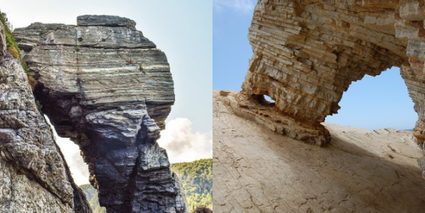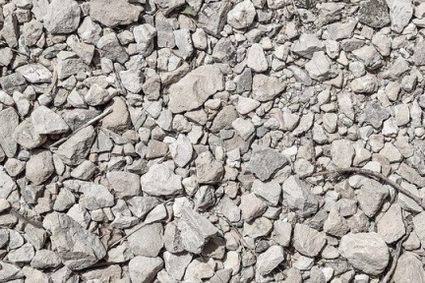Limestone Calculator
This limestone calculator, or limestone rock calculator, will help you find how much limestone rock you need for a crushed stone driveway, walkway, or any area or thickness of limestone rock bed you want to have.
This text will briefly cover what limestone is, what limestone is used for, and how to calculate how much limestone you need for any project. Keep on reading to start learning.
What is limestone rock?
Limestone is a sedimentary rock with high concentrations of, or entirely, calcium carbonate that mostly comes from decomposed marine organisms.
Limestone is usually white, but it gets grayish to almost black in color with the presence of carbon or any organic matter. Traces of manganese or iron oxide can also discolor limestone rocks to a yellowish or reddish tinge.

What is limestone used for?
Limestone has a lot of uses in various industries. We cut limestones into bricks, pavers, or tiles in the construction industry or pulverize them for cement production. Check out our cement calculator to learn more about cement.
We can also crush limestones and use them as aggregates to mix with cement and sand for different concrete and mortar mixes. Other industries also use limestone, such as manufacturing paper, glass, and even paint. In agriculture, farmers can also add processed limestone called slaked lime to their fertilizer to neutralize acidic soils to achieve the best soil pH for a much desirable plant growth and product yield.
Our primary focus in this calculator revolves around the applications of limestone rocks or aggregates used in landscaping, walkways, and driveways, to name a few, like how we also use gravels or river rocks in a gravel driveway. In the next section of this text, we'll discuss how to use our limestone calculator.

How to use our limestone calculator?
Using our limestone rock calculator is straightforward and simple. Here are the steps to follow:
-
The first step is to select the limestone type you wish to use. Limestone rocks vary in densities depending on their rock sizes. Smaller pieces of limestone rocks have higher bulk density than larger-size limestone rocks.
-
If you know the density of the limestone rock you plan to use, select Enter custom limestone density from the limestone type dropdown options, then change the density value in the Average density variable. The average density of limestone is
1.55-2.75 g/cm³. -
The next step is to enter the area's dimensions (length and width) you want to cover with limestone rocks and the depth. Doing so will display the volume you will be required to fill with limestone rocks.
-
Enter your projected wastage percentage for this project. In construction, we often either spill materials to waste or have changes in the actual work. Including a wastage value prepares us from having to get back to the store for more products. It's also nice to keep some extra volume of materials for future uses.
Doing the steps above will result in a limestone weight calculation for your needed limestone rocks. You have this weight value, as suppliers tend to ask buyers how much limestone they need in terms of weight. Our limestone calculator covers the most typical weight units we use in construction. If you want to convert the resulting weight into other units, you can use our weight converter for that.
You can also enter the price per unit weight or the price per unit volume, whichever you know, to find the estimated cost of your project.
Now that you know how to use our calculator, wouldn't it also be nice to know how to calculate how much limestone you need manually? Let's learn how to do it in the next section of this text.
How do you calculate how much limestone you need?
To calculate how much limestone you need, the first thing you have to do is multiply the dimensions of the area you want to cover by how deep your limestone should be, as shown in the equation below:
volume to be filled = length × width × depth
Having this volume, we can then find the volume of limestone we need while considering the wastage percentage, using this equation:
volume needed = volume to be filled × (1 + wastage)
Since we also need to know the weight of the limestones we need, we can determine it by multiplying our calculated volume needed by the density of our limestone, as shown here:
weight of limestone needed = volume needed × density of limestone
💡 You can also use the same formulas to determine other similar materials, like sand, gravel, and other rocks. All you have to do is use the density of the material you want. Quickly determine the amount and cost of these materials using our sand calculator or gravel calculator We also have our river rock calculator that covers other types of stones that we typically use for the same purpose.
Sample crushed limestone weight calculation
Suppose you need to build a crushed limestone driveway for a friend. Her driveway measures 3 meters wide by 10 meters long, and she wants her driveway to have its final layer to be 10 centimeters (0.1 meters) deep of crushed limestone rocks with a density of 2,410 kg/m³. Let's say you want to consider a 10% wastage percentage for this project. Let us now determine how much limestone you need to purchase by starting with the volume to be covered:
volume to be filled = length × width × depth
volume to be filled = 10.0 m × 3.0 m × 0.1 m =3.0 m³
Then, we can go ahead and follow the procedure by incorporating the wastage percentage in the volume, as shown in this equation:
volume needed = volume to be covered × (1 + wastage)
volume needed = 3.0 m³ × (1 + 10%) = 3.3 m³
Finally, we obtain the weight of the limestone rocks we need, as shown here:
weight of limestone needed = volume needed × density of limestone
weight of limestone needed = 3.3 m³ × 2,410 kg/m³ =7,953 kg
Based on our crushed limestone calculations above, you can now call your local supplier for the availability of 7,953 kg of crushed limestone rocks. You can also use our calculator as a limestone driveway calculator to see if our crushed limestone calculations were correct 😊.
How much does a yard of limestone weigh?
A cubic yard block of limestone weighs approximately 2.0 US tons or roughly around 4,000 pounds. On the other hand, a cubic yard box filled with crushed limestone rocks weighs around 1.3 to 1.9 US tons, depending on the average size of the rocks. Solid limestone weighs a lot heavier than crushed limestone rocks since, in crushed limestone rocks, we now also consider air in the total cubic yard volume.
How much does a cubic foot of limestone weigh?
A cubic foot of limestone rocks weighs around 96 to 150 lbs (44 to 68 kg). On the other hand, a cubic foot block of limestone cut from a large piece of limestone would weigh around 168 lbs (76 kg). The difference in solid and crushed limestone weights depends on the void spaces within the considered cubic foot volume. Since crushed limestone has void spaces between each particle, those void spaces decrease its weight per cubic foot.
How much does a ton of limestone cover?
For a thickness of 4 inches (or approximately 10 centimeters), a US ton of limestone can cover an area of around 40 to 54 square feet (or around 4 to 5 square meters).
If you only need an inch-thick layer of limestone rock cover, you will be able to cover around 175 to 215 square feet (or around 16 to 20 square meters) of area. However, the actual area that a US ton of limestone can cover still depends on the actual density of the limestone rocks.
Does limestone react with acid?
Yes. In fact, limestone easily reacts and dissolves even with weak acids. The calcium carbonate present in the limestone reacts easily with hydrogen ions present in acids. Hydrogen ions break down the chemical composition of calcium carbonate to produce carbon dioxide, water, and other chemical compounds. This makes limestone structures, man-made or naturally occurring, crumble in acid rain.
What is limestone composed of?
Limestone is mainly composed of calcium carbonate, both in the form of aragonite and calcite. Minerals may also be in a limestone together with the small grains of limestone called clasts surrounded by even smaller particles of limestones (microscopic in size) called micrite. Manganese or iron in limestone contribute to a yellowish to reddish color of limestone. While the presence of organic matter in the limestone makes it turn gray or black.
What does the limestone say to the geologist?
"Don't take me for granite." 😂 Though limestone and granite are two rocks a geologist would not really be confused about due to their differences in physical characteristics, it is also worth noting that limestone is a sedimentary rock while granite is an igneous rock. The extreme temperature and pressure that granite had to undergo to reach its final state make it denser and harder than limestone. Limestone must actually be proud to be taken for granite, but it chose not to.